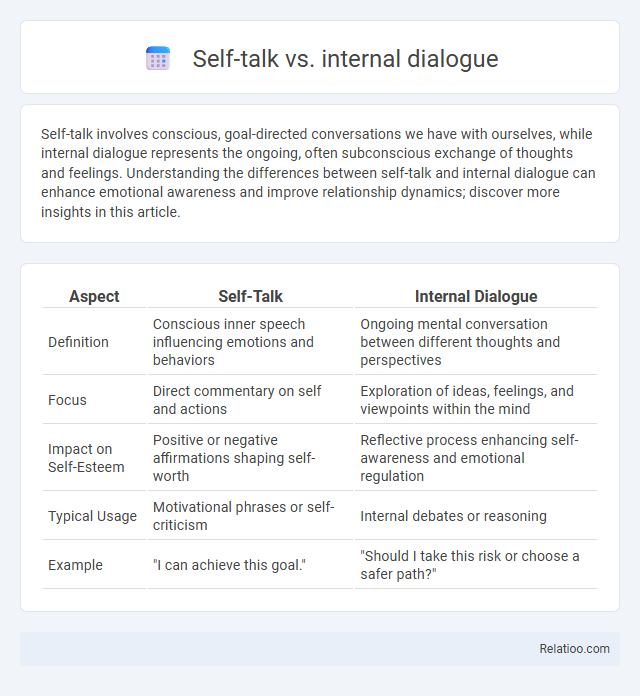Self-talk involves conscious, goal-directed conversations we have with ourselves, while internal dialogue represents the ongoing, often subconscious exchange of thoughts and feelings. Understanding the differences between self-talk and internal dialogue can enhance emotional awareness and improve relationship dynamics; discover more insights in this article.
Table of Comparison
| Aspect | Self-Talk | Internal Dialogue |
|---|---|---|
| Definition | Conscious inner speech influencing emotions and behaviors | Ongoing mental conversation between different thoughts and perspectives |
| Focus | Direct commentary on self and actions | Exploration of ideas, feelings, and viewpoints within the mind |
| Impact on Self-Esteem | Positive or negative affirmations shaping self-worth | Reflective process enhancing self-awareness and emotional regulation |
| Typical Usage | Motivational phrases or self-criticism | Internal debates or reasoning |
| Example | "I can achieve this goal." | "Should I take this risk or choose a safer path?" |
Understanding Self-Talk: Definition and Importance
Understanding self-talk involves recognizing the internal conversations that shape your thoughts, emotions, and behaviors. Unlike general internal dialogue, which encompasses all mental chatter, self-talk specifically refers to intentional, conscious statements you make to yourself that influence motivation and self-perception. Mastering positive self-talk enhances mental resilience and improves decision-making, making it a critical component of personal development.
What Is Internal Dialogue? Key Characteristics
Internal dialogue refers to the ongoing conversation one holds within their mind, involving thoughts, reflections, and mental debates. Key characteristics include its dynamic nature, fluid shifts between perspectives, and its role in problem-solving, emotional regulation, and decision-making processes. Unlike fragmented self-talk, internal dialogue represents a more coherent and interactive mental exchange, often resembling a two-way conversation with oneself.
Self-Talk vs Internal Dialogue: Core Differences
Self-talk refers to the explicit, conscious verbalizations or thoughts individuals use to guide behavior and manage emotions, often occurring externally or internally. Internal dialogue involves a more complex, dynamic exchange between different aspects of the self, resembling a conversation that fosters deeper self-reflection and problem-solving. Core differences lie in self-talk's directive and motivational nature versus internal dialogue's reflective and integrative process.
Psychological Functions of Self-Talk
Self-talk serves as an internal communication tool that influences motivation, emotional regulation, and cognitive processing, playing a crucial psychological role in self-regulation and problem-solving. Internal dialogue often involves a dynamic exchange between multiple perspectives within the mind, facilitating critical thinking and self-reflection. Compared to general self-talk, which may be more repetitive and procedural, internal dialogue supports complex mental functions such as decision-making and moral reasoning by engaging contrasting viewpoints internally.
The Role of Internal Dialogue in Decision-Making
Internal dialogue plays a crucial role in decision-making by enabling individuals to evaluate options, anticipate outcomes, and reflect on personal values through an ongoing mental conversation. Unlike general self-talk, which often involves motivational or emotional affirmations, internal dialogue incorporates multiple perspectives and critical thinking processes that facilitate complex problem-solving. This dynamic inner communication shapes cognitive frameworks, influencing choices and enhancing self-awareness during decision-making tasks.
Positive Self-Talk: Benefits and Strategies
Positive self-talk enhances mental resilience by reinforcing optimistic beliefs and reducing stress, which improves overall well-being and performance. Internal dialogue involves ongoing mental conversations that shape self-perception, while self-talk specifically refers to conscious or subconscious verbalizations influencing emotions and behaviors. Effective strategies for positive self-talk include practicing affirmations, reframing negative thoughts, and maintaining mindfulness to promote constructive internal conversations and boost confidence.
Navigating Negative Internal Dialogue
Navigating negative internal dialogue requires recognizing the subtle differences between self-talk and internal dialogue: self-talk involves brief, often subconscious affirmations or criticisms, while internal dialogue is a continuous, reflective conversation within your mind. Your awareness of these mental processes can empower you to challenge and reframe negative thoughts, replacing harmful self-talk with constructive internal dialogue. Developing this skill reduces emotional distress and fosters a resilient mindset, enhancing your overall mental well-being.
How Self-Talk Influences Mental Health
Self-talk significantly impacts your mental health by shaping emotional responses and cognitive patterns through the continuous stream of internal commentary. Unlike internal dialogue, which involves a reflective exchange between different aspects of the self, self-talk directly reinforces beliefs and attitudes, potentially improving or worsening stress, anxiety, and self-esteem. Positive self-talk encourages resilience and coping strategies, while negative self-talk can contribute to mental health challenges like depression and reduced motivation.
Techniques to Improve Internal Dialogue
Improving your internal dialogue involves techniques such as mindfulness meditation, which helps you become aware of negative thought patterns and replace them with positive affirmations. Cognitive restructuring is another effective method that allows you to challenge and reframe distorted self-talk into constructive internal conversations. Practicing journaling enables you to externalize your thoughts, making it easier to identify and adjust harmful self-talk into supportive internal dialogue.
Cultivating Healthy Communication with Yourself
Self-talk involves the conscious or subconscious verbal messages directed at oneself, shaping thoughts and emotions, while internal dialogue represents a dynamic exchange between different parts of the self, fostering insight and problem-solving. Cultivating healthy communication with yourself through positive self-talk and reflective internal dialogue enhances emotional resilience, reduces negative self-criticism, and promotes mental well-being. Techniques such as mindfulness, cognitive restructuring, and affirmations are effective in transforming self-talk patterns and nurturing constructive internal conversations.

Infographic: Self-talk vs Internal dialogue
 relatioo.com
relatioo.com